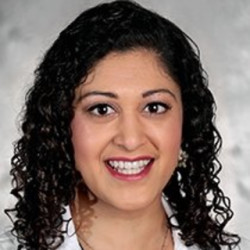On my internal medicine rotation in medical school, I joined a group of nine long and short white-coated individuals: one attending, two residents, two interns, two medical students, one pharmacist, and one pharmacy student. For three hours each morning, at least, we did walk rounds, navigating down sterile hospital hallways, pushing our computer on wheels, and avoiding any instincts to eat, drink, or pee to have time to discuss each and every patient on our census. We marched behind one another in the assumed hierarchy of attending then residents then medical students then pharmacists.
Mr. Jones had the bacterial infection C. diff. He lay in bed all day passing stool, afraid to even stand for more than a few seconds. The 10 of us put our hands underneath the electric hand sanitizer pump. Click and dispense. 10 times. We then all put on gloves and yellow plastic isolation gowns. We squeezed into his room and stayed for a total of two minutes as we watched the attending physician press on his belly and encourage him to work with physical therapy. I wondered how it made him feel, to be observed by all of us nameless yellow figures for a fleeting moment. With C. diff exposure, you have to wash your hands with soap, so we all proceeded to line up at the one sink by his room. I couldn't help but think, “What was the point of all that?”
In addition to walk rounds, another popular rounding method is table rounding. This format, in a conference room setting, lends itself to uncensored discussions. While there are benefits to speaking frankly about a prognosis or plan, there is also room for uninhibited reflections. When discussing Mrs. Marshall who attempted suicide by consuming a bottle of blood thinner, the attending physician had us all guess her pending lab value that shows how long it takes for blood to clot. It felt beyond crass. During table rounds, as we talked about diseases, lab values, and medications away from the patient, mistakes regarding the sex of the patient were frequently made. There was also often confusion about whose responsibility it was to communicate with the patient about the medical plan; we frequently placed orders for lab and imaging tests that were done before we updated the patient about the plan.
Primary medicine teams are not the only ones to round; this format is also utilized by consult services. I have seen patients followed by up to five different consult services, which means that a patient is visited during the day by approximately 15 additional clinicians (if you count a medical student, resident, and attending physician per consult service). When I was on the geriatric consult service, a patient we were evaluating stated, “I’ve answered these questions so many times already. It’s depressing. Don’t you all talk to each other?” You feel like the luckiest team if you run into a consult service you share a patient with and can discuss the plan in an interdisciplinary way before waiting until noon when rounds traditionally end. Touching base with consultants is not the only thing that has to wait until noon: discharges and family updates are also notoriously postponed.
Formal presentations on rounds were a particular source of anxiety for me as a medical student. It is one of the few times of the day I interacted directly with the attending physician and so it mattered significantly for my evaluation. Memorization of a presentation seemed to show an additional level of skill and expertise; but it was hard to focus on the learning part of rounds when I was worried about when it would be my turn to speak. When I became an attending, a student apologized to me for not having the presentation memorized; another apologized for saying his plan before completing his assessment. In their distress, I remembered my own apprehensions as a student and tried to assuage their concerns: “You don’t need to be sorry, there is no one right format.”
I’ve become a firm believer that rather than focusing on the performance of doctoring, we should be focused on doctoring. This performance of rounding takes the emphasis away from effective, efficient, and educational caregiving. Rounding can be so tedious in some institutions and specialties that it can be a primary reason why a student does not pursue a specific specialty. Instead, we should be finding ways to inspire and engage clinicians — and even better, also patients and families.
There was one more type of rounding style I participated in as a medical student, albeit rarely. In patient-centered rounds, we would page nursing staff and case management to join us for rounds. When we entered the patient room, we went around and introduced ourselves by name and position. The medical student or intern gave the subjective and objective part of the presentation. Nursing staff would provide an update. The upper-year resident would provide a summary and describe the plan for the day. The attending physician listened carefully to correct any mistakes and answer any questions. Patients often said: “I can’t believe all these people are helping take care of me! I am so grateful.” It was clear how much of a difference it made for this patient to see and hear from all the team members at once and avoid repetitive conversations. Moreover, presenting in front of patients challenged us to translate the medical jargon of our minds into comprehensible statements with nuance and uncertainty. This prevented me from hiding behind fancy terminologies and instead learned how to answer the basic and important question, “What is really going on and what are we really doing?”
The conclusion of this article is not that we should do away with rounding completely, or that there is only one way to round. We first need to remind ourselves that the goal of medicine is to care for patients, that patients understand that care, and for clinicians to learn and implement the care plans. As a field, and as individual clinicians, we need to think more critically about how we can effectively and efficiently use our time — as clinicians, educators, and learners. I personally have a number of ground rules. 1) Always speak compassionately about patients and families as if you are talking to them directly. 2) Don’t memorize your presentations. 3) Only highlight changes or abnormalities in the objective data (exam, labs, vitals). 4) Don’t regurgitate or repeat information in the assessment and plan; spend the time on rounds to highlight your clinical reasoning and share your ongoing hypotheses.
I would encourage all attending physicians when they start on service to ask themselves and their learners, “How can we make the most out of rounds today? What should we adapt with regards to our rounding methods based on the specific learners and patients we have right now?” If it’s not helping patients or learners, we shouldn’t be doing it. The culture of rounds can and should be dynamic, innovative, and efficient, rather than a relic of how medicine has always been practiced.
How do you like to round? Defend your favorite style in the comments.
Charlotte Grinberg is a hospice and palliative doctor for Tufts Medicine. Her writing has appeared in JAMA, Health Affairs, and the Annals of Internal Medicine. She tweets at @drcharlotteG. She was a 2020–2021 Doximity Op-Med Fellow and continues as a 2021-2022 Op-Med Fellow.
All names and identifying information have been modified to protect patient privacy.
Image by romeocane1 / Getty







